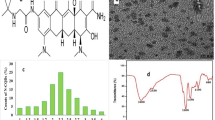Abstract
In this study, nitrogen-doped carbon quantum dots CQDs, synthesized from malic acid and EDTA, were encapsulated using sodium alginate. Different parameters affecting loading capacity (such as capsules’ sizes, complexation solution’s concentration and encapsulation method) were investigated. After that, ibuprofen (Ibu), taken as a model drug, was tagged by CQDs to form Ibu-CQDs adduct, and then encapsulated using sodium alginate. The results showed high values of loading capacity of CQDs, ibu and Ibu-CQDs capsules; 86.3%, 92% and 67%, respectively. It was proved that Ibu-CQDs release could be tracked using spectrofluorometry and UV-vis spectroscopy. The maximum release of Ibu-CQDs was 42% after 24 h. Temperature’s effect on drug release was also studied and it was found that the best release was achieved at higher temperatures (40 °C), which corresponds to the illness state. Release medium’s pH was also varied to simulate the pH of different parts of the gastrointestinal tract, and it was found that the best drug release can occur in the duodenum instead of the stomach. The current Ibu-CQDs capsules hold great promise for further studies in drug release and bioimaging applications.
Graphical abstract
















Similar content being viewed by others
Data Availability
The authors declare that the current manuscript have only “Supplementary Information’s Document” as data and materials.
References
Kairdolf BA et al (2013) Semiconductor quantum dots for bioimaging and biodiagnostic applications. Annu Rev Anal Chem 6:143–162
Briscoe J et al (2015) Biomass-derived carbon quantum dot sensitizers for solid-state nanostructured solar cells. Angew Chem Int Ed 54(15):4463–4468
Zhang R, Chen W (2014) Nitrogen-doped carbon quantum dots: facile synthesis and application as a “turn-off” fluorescent probe for detection of Hg2+ ions. Biosens Bioelectron 55:83–90
Wang Y, Hu A (2014) Carbon quantum dots: synthesis, properties and applications. J Mater Chem C 2(34):6921–6939
Zhang M et al (2017) Near-infrared light triggered photo-therapy, in combination with chemotherapy using magnetofluorescent carbon quantum dots for effective cancer treating. Carbon 118:752–764
Mishra M (2015) Handbook of encapsulation and controlled release. CRC press
Matoulkova P et al (2013) Information and awareness concerning ibuprofen as an ingredient in over the counter analgesics: a questionnaire-based survey of residents of retirement communities. Acta Pol Pharm 70(2):333–338
Yilmaz E, Sarp G (2020) Graphene-like MoS 2-modified magnetic C-dot nanoflowers: an efficient magnetic solid-phase extraction adsorbent for monitoring of trace amounts of ibuprofen. Anal Methods 12(12):1570–1578
Qu Z, Liu L, Sun T, Hou J, Sun Y, Yu M, Wang L (2020) Synthesis of bifunctional carbon quantum dots for bioimaging and anti-inflammation. Nanotechnology 31(17):175102
Bayoumy AM, Refaat A, Yahia IS, Zahran HY, Elhaes H, Ibrahim MA, Shkir M (2020) Functionalization of graphene quantum dots (GQDs) with chitosan biopolymer for biophysical applications. Opt Quant Electron 52(1):16
Sheng W et al (2006) In-situ encapsulation of quantum dots into polymer microspheres. Langmuir 22(8):3782–3790
Wang C-H, Hsu Y-S, Peng C-A (2008) Quantum dots encapsulated with amphiphilic alginate as bioprobe for fast screening anti-dengue virus agents. Biosens Bioelectron 24(4):1012–1019
Sundarrajan P et al (2012) One pot synthesis and characterization of alginate stabilized semiconductor nanoparticles. Bull Kor Chem Soc 33(10):3218–3224
Li J, Sun J, Bai S, Wu X (2020) Multifunctional Mesoporous CDQs/BMMs with strong fluorescent property and sustained drug releasing performance. Chemistry Select 5(15):4786–4792
Parani, Sundarrajan; Lakshmi, Baddireddi Subhadra; Pandian, Kanniyan. Biopolymer encapsulation of CdTe quantum dot for In vitro controlled drug delivery release of 6-mercaptopurine. In: Advanced Materials Research. Trans Tech Publications, 2012. p. 258–262
Simonin J-P (2016) On the comparison of pseudo-first order and pseudo-second order rate laws in the modeling of adsorption kinetics. Chem Eng J 300:254–263
HOFF RM, BRICE KA, Halsall CJ (1998) Nonlinearity in the slopes of Clausius− Clapeyron plots for SVOCs. Environmental science & technology 32(12):1793–1798
Xu S et al (2018) Calcium alginate capsules encapsulating rejuvenator as healing system for asphalt mastic. Constr Build Mater 169:379–387
Mohammad N, Atassi Y, Tally M (2017) Synthesis and swelling behavior of metal-chelating superabsorbent hydrogels based on sodium alginate-g-poly (AMPS-co-AA-co-AM) obtained under microwave irradiation. Polym Bull 74(11):4453–4481
Acharya M et al (2017) Infrared spectroscopy for analysis of co-processed ibuprofen and magnesium trisilicate at milling and freeze drying. Acta Chim Slov 64(1):45–54
Yu P et al (2012) Temperature-dependent fluorescence in carbon dots. J Phys Chem C 116(48):25552–25557
Méndez-Arriaga F et al (2008) Ultrasonic treatment of water contaminated with ibuprofen. Water Res 42(16):4243–4248
Funding
Not applicable. The current work is an academic work in a higher education institute.
Author information
Authors and Affiliations
Contributions
Hytham Hassan: Collected the data, performed the analysis, and participate in writing the paper.
Rama Alqassar Bani Almarjeh: Conceived and designed the analysis, performed the analysis, and participate in writing the paper.
Yomen Atassi: Supervised the whole work, Conceived and designed the analysis, performed the analysis, participate in writing the paper and revised the whole work.
Corresponding author
Ethics declarations
Competing Interests
The authors declare that they have no conflict of interests.
Additional information
Publisher’s Note
Springer Nature remains neutral with regard to jurisdictional claims in published maps and institutional affiliations.
Supplementary Information
ESM 1
(DOCX 312 kb)
Rights and permissions
About this article
Cite this article
Hassan, H., Almarjeh, R.A.B. & Atassi, Y. In-Vitro Ibuprofen Release Monitoring Using Carbon Quantum Dots. J Fluoresc 31, 289–303 (2021). https://doi.org/10.1007/s10895-020-02659-z
Received:
Accepted:
Published:
Issue Date:
DOI: https://doi.org/10.1007/s10895-020-02659-z




